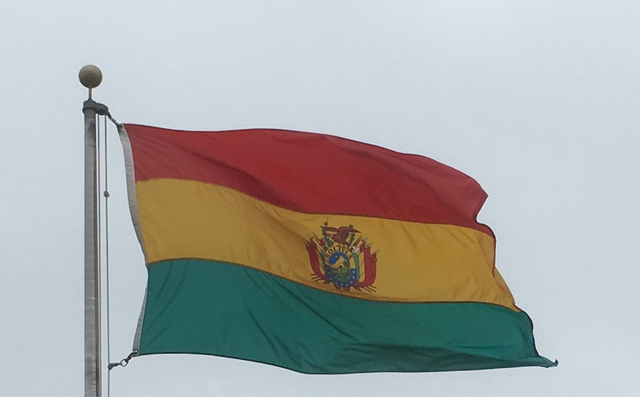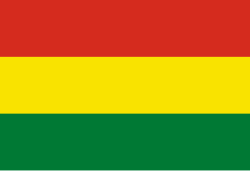Top Qs
Timeline
Chat
Perspective
Flag of Bolivia
National flag From Wikipedia, the free encyclopedia
Remove ads
The national flag of the Plurinational State of Bolivia was originally adopted in 1851. The state and war flag is a horizontal tricolor of red, yellow and green with the Bolivian coat of arms in the center.


According to the revised Constitution of Bolivia of 2009, the Wiphala is considered a national symbol of Bolivia (along with the tricolor flag, national anthem, coat of arms, the cockade; and kantuta and patujú flowers).[3]
Despite its landlocked status, Bolivia has a naval ensign used by navy vessels on rivers and lakes. It consists of a blue field with the state flag in the canton bordered by nine small yellow five-pointed stars, with a larger yellow five-pointed star in the fly. The nine small stars represent the nine departments of Bolivia, and the larger star the nation's right to access the sea (access that it lost in 1884 in the War of the Pacific).
Remove ads
Description
Summarize
Perspective
Design and dimensions
The national flag of Bolivia is described as a tricolor rectangle, with the colors red, yellow and green, in a ratio of 1:1:1, meaning three horizontal bands, with the red on the superior part occupying a third of the flag's width, yellow in the middle band using the same width, and green in the inferior part, using the last third.[4]
The dimensions of the flag had not been defined since its adoption in 1851. Supreme Decree No. 27630 of 2004 finally established that the size of the national flag be of 7.5 squares width by 11 squares long, giving a ratio of 15:22.
Color and symbolism
The first description of Bolivia's national flag, together with the significance of these, were first established by the Supreme Decree of 1888 during the government of President Gregorio Pacheco, which specifies that:
- Red: "represents the blood shed by our heroes for the birth and preservation of the Republic"
- Yellow: "represents our wealth and resources."
- Green: "represents the richness of our natural areas as well as hope, a foundational value of our society"
The exact colors of the Bolivian flag have been established by the Supreme Decree of 2004:[5]
The colours of the tricolor can also be found in the Bolivian Wiphala. The Wiphala has been included into the national colours of the Bolivian Air Force such as on the executive Dassault Falcon 900EX.[10] The Wiphala is also officially flown on governmental buildings such as the Palacio Quemado and parliament alongside the tricolor since the introduction of the revised 2009 constitution.[11]
Remove ads
Historical flags
Summarize
Perspective

The current Bolivian flag was officially adopted on 31 October 1851 during the presidency of Manuel Isidoro Belzu.
According to Supreme Decree No. 27630 of 19 July 2004, during the presidency of Carlos Mesa, it was established that the civil flag used in civic, public and patriotic celebrations will be used without the National Shield, while the flag used by the state in official acts will include the shield in its center.
During the presidency of Evo Morales, through Supreme Decree No. 241 of 5 August 2009, some symbolic modifications were made to the flag. It was also established that for both the civil flag and the flag used by the State in official acts they should be raised on the right side and the wiphala on the left side.
- Colonial flag, Spanish Empire flag (1506–1825/1821 in Peru, and Bolivia), (1506–1785/1701 in other colonies), (1506–1821 in Philippines)
- Bandera Menor, Civil flag (1825–1826)
- Bandera Mayor, State flag (1825–1826)
- Bandera Menor, Civil flag (1831–1851)
- Bandera Mayor, State flag (1831–1851)
- Peru-Bolivian Confederation (1836–1839)
- Former naval ensign of Bolivia (1966–2013)
- Flag of the Armed Forces of Bolivia
Remove ads
See also
- Coat of arms of Bolivia
- Flag of the Patujú flower
- Wiphala
- Flag of Rojava, similar flag to the pre-1851 flag
- Flag of Hungary, nearly identical design (white stripe instead of yellow)
- Flag of Ghana, nearly identical design (defaced with a black five-pointed star)
- Flag of Mali, a rotated version of the flag
- Flag of Guinea, a rotated version of the flag
- Flag of Ethiopia, an inverted version of the flag
References
External links
Wikiwand - on
Seamless Wikipedia browsing. On steroids.
Remove ads














